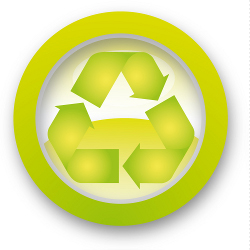What Do Those Numbers on Plastic Bottles Mean Anyways?
Sharon Santino,
Aug 12, 2011
 If you've ever wondered what those curious little numbers on the bottom of your plastic bottles stand for, then you're in the right place.
If you've ever wondered what those curious little numbers on the bottom of your plastic bottles stand for, then you're in the right place.
Plastic bottles are marked at their base with a number called a Resin Identification Code. Developed in 1988, the codes were created by the Society of the Plastics Industry (SPI) and are used internationally. The marks are used to identify and separate different types plastics. The numbers run from 1 to 7 and each number represents a different type of polymer.
1 - PET (Polyethylene Terephthalate) sounds complicated, but it is actually the building block of polyester. The majority of PET is made into synthetic fiber, but it can also be used for plastic containers. PET, patented in 1941, is naturally colorless, semi-crystalline, shatterproof and very light. It is used in soft drink containers.
Since plastic bottles made of PET usually contain very little filler, they are easily recycled and are often made into items like our Tempo 100% Recycled PET Sling.
2 - HDPE (High Density Polyethylene) was created in the 1930s from petroleum. HDPE is related to LDPE (Low Density Polyethylene) and PP (Polypropylene). With billions of pounds are produced each year, it is one of the most widely used plastics. It is tough, non-toxic and opaque, making it ideal for items as such as bottle caps, milk jugs, insulated containers (like our Coleman 1/2 Gallon Jug), folding chairs, tables - and even hula hoops. In fact, about one-third of all plastic toys are made from HDPE.
3 - PVC (Polyvinyl Chloride), a type of vinyl, is often used in construction because it is inexpensive and easy to assemble. It was discovered in the late 19th century but wasn't adapted for commercial until 1926.
PVC used to make pipes (those pipes are put places where metal pipes would get corroded), to insulate wires and to create door and window frames. Since it is waterproof, you will often find it in items like our Ice Chest and our PVC Cosmetic Bag. Interestingly enough, Polyvinyl Chloride is also used to make vinyl records.
4 - LDPE (Low Density Polyethylene) is related to HDPE (High Density Polyethylene), with the difference being obvious - it is less dense. It is more flexible than its sibling and is primarily used in plastic wrap, carrying bags, and sacks. It is also used to coat the insides of screw caps, lids and bottles.
5 - PP (Polypropylene) is right in between HDPE (High Density Polyethylene) and LDPE (Low Density Polyethylene). It is a tough plastic and can be used to make hard items like a Top-This Ice Cream Scoop. It is also used in to make strong ropes (as seen on our Poly Pro Drawstring Tote) or tough fabric (like the material that makes up our George Celebration Tote).
6 - PS (Polystyrene) is derived from petroleum and is hard but brittle until it is mixed with strengtheners. Once this is done, it is used in products like CD cases, disposable eating utensils and plastic models. It can also be foamed and made into drinking cups, packing peanuts and beads - like the ones seen in our Microbead Pillow. Polystyrene does not biodegrade naturally, but it is recyclable.
7 - is the classification for "other" types of plastics - basically, any type that does not fit the categories above. Sometimes this kind of plastic is a mix of the above types or is completely different all together.
So, now you know what these numbers mean. If you have questions about the types of plastics used on our site, call your rep or contact us for more information.


